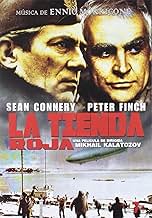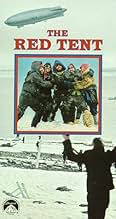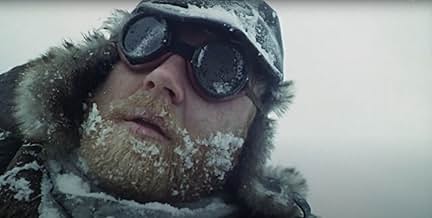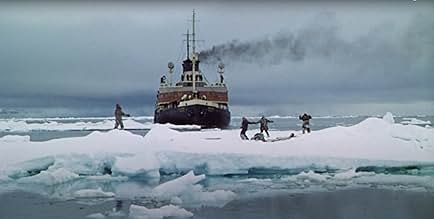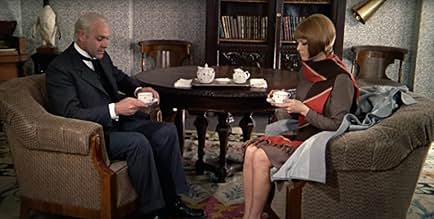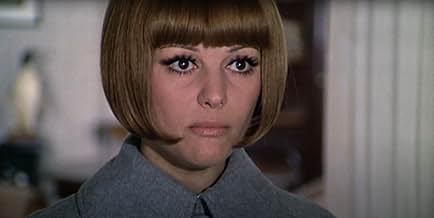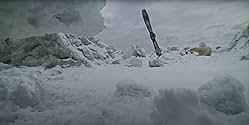Torn by personal guilt, Italian General Umberto Nobile reminisces about his failed 1928 Arctic expedition aboard the airship Italia.Torn by personal guilt, Italian General Umberto Nobile reminisces about his failed 1928 Arctic expedition aboard the airship Italia.Torn by personal guilt, Italian General Umberto Nobile reminisces about his failed 1928 Arctic expedition aboard the airship Italia.
- Awards
- 2 nominations total
- Einar Lundborg
- (as Hardy Kruger)
- Renato Alessandrini
- (uncredited)
Featured reviews
The film is not condescending in that there is a genuine awe and respect for the great polar explorers. Roald Amundsen's spectral presence (played by Sean Connery) is magnetic and haunting.
Another cinematic precursor of this one may be Battle of the River Plate (1956), also starring Peter Finch, a film fascinated with the concept of historical spectacle. The actual crash is a matter of history, indicated at the start of the film and is not a spoiler. The filming of the crash is spectacular and crazy glorious cine-trauma.
Finn Malmgren is one of the most interesting characters, he has a death wish, a love of the emptiness and Arctic loneliness. I think maybe it's something that they all share. Why would anyone venture into this morass of crumbling ice otherwise?
The film is framed by a trial, Nobile trying himself, in his mind, for the disaster, this is very trippy.
The entire film actually takes place in the General's mind. He calls back various participants to the event, to re-live what happened, and ultimately to pass judgment on him. It is this framing device that makes the film unique, for it examines Nobile's leadership from a divergent points of view, allowing the viewers to make their own judgment as well. It is a theatrical device to be sure, but it works in this film. In time we come to learn that truth often walks on two legs and has a left and right hand. "Yet we must have judgment", says one of the participants, and so they do. These scenes which all take place in Nobile's apartment in Rome with it's warmth and comfort, provide a wonderful contrast to the stark reality of the struggle for survival at the Arctic Pole.
The film is beautifully written and the acting is of a high level throughout. Sean Connery, ridding himself of his Bond image, plays Roald Amundsen, the great Arctic explorer at the end of his days. It is Amundsen who exemplifies the qualities a great leader should have. It is the first and in some ways still the best of Connery's wise old man performances. He is also the one participant Nobile has most conspicuously not brought back. After intruding on the proceedings like some force of nature, he describes how he had reached the wreak of the Italia, only to crash land and be stranded. With nothing to do but wait to freeze to death he finds solace in his final moments of life with a book he has found strewn among the wreckage. The cynical Lundborg scornfully rejects this "final touch" as "theatrical" "But who would I be acting for?" Amundsen asks. "Yourself" Lundborg replies. "But that isn't acting," Connery wisely replies, "That's necessary. The trick is to choose the right part." The film is filled with great lines like this. Claudia Cardinale, as Nurse Valaria, provides the emotional center of the film. She resents the good people of King's Bay capitalizing on the disaster, yet she has no misgivings whatever in playing on Amundsen's sense of guilt to get him to mount a rescue attempt. After all he had introduced her lover, the Meteorologist, Finn Malgrem to Arctic exploration. She is also willing to offer herself to Lundborg if he will risk his life to fly in unsafe weather conditions. It is her bitter confrontation with Nobile after he has been safely brought back to King's Bay while the others were left freezing on the ice, that is the beginning of his sleepless nights. His inability to stop Zampi, his ambitious second in command from leaving the red tent with Mariano and Malgrem in a vain attempt to reach help, would result in the Meteorologist being lost on the ice. "You cracked like the ice." she tells the General. "We shall never meet again I hope. And I hope you never forget." He doesn't.
Peter Finch as Nobile carries the film, and he is in every way up to the task. He manages to convey the intelligence, courage, vanity and despair of this self-doubting individual. He is a man who both admires Amundsen and resents always being compared with him. Hardy Kruger plays the dashing Aviator Lundborg with a nice blend of charm and hard edge cynicism. He is the first to reach the survivors. His motives for rescuing the Nobile over the General's objections that he take the other members of his expedition first, some of whom are badly injured, may have been less than admirable, but it is this act that will ultimately save the others. Lundborg finally persuades the General to go with a combination of threats,(he will leave him and the others behind), reassurance,(six quick trips and it will be over), and finally reason, (the General is badly needed at King's Bay to organize the rescue). The others also agree the General must go. It is only when he is safely back at King's Bay, that he realizes his actions have been badly misconstrued as an act of desertion. By that time weather conditions have changed again and it is impossible to go back and rescue the others by air. "What do they think I've done?" he asks Captain Romagna, the ineffectual rescue coordinator, after reading a cable from Rome placing him under arrest. "They think you have done what you have done, I suppose." Romagna lamely replies. While aboard ship, Nobile radios his friend Samoilovitch to use the icebreaker Krassin to rescue the others. This he does. "Men are judged by their actions and their actions by their success." The General's decision to leave his men led to his being able to radio the Krassin which in turn led to the rescue of his men. "His actions, therefor were correct."
Lastly, Ennio Morricone's lush score captures both the romance of a great endeavor being undertaken and the desolate, ethereal beauty of the Arctic. This film deserves to be seen and heard, and one can only hope that one day it will be restored.
Highly imaginative, fictionalized version of these sad events . The film deal with General Nobile and Amundsen , but this is not a story of his race with Captain Scott to reach the South Pole -similarly to Cook and Peary in North Pole- , but a later episode in his moving career . Interesting and thought-provoking screenplay by prestigious writers : Richard DeLong Adams and Ennio De Concini though the script holds some inconsistencies in the dialogue . Big name cast who has to struggle hard to come to terms the strange happenings as when there appear ghost roles and all of them form a peculiar jury against General Nobile to be judged accused for desertion and cowardice . Very good acting by Peter Finch as Italian General Umberto Nobile torn by personal guilt . In between his last two assignment as James Bond , Connery gave some nice acting for the cinema and this portrait of the Norwegian explorer Amundsen is one of them . Sensitive and moving musical score by the great maestro Ennio Morricone . And colorful pictorial qualities of the cinematography are very strong . The yarn was compellingly directed by Mikhail Kalatozov (The cranes are flying , I Am Cuba) .
This roust man-versus-nature epic picture was well based on historical and biographic accounts , there are the followings : Umberto Nobile was an Italian aviator, aeronautical engineer and Arctic explorer. Nobile was a developer and promoter of semi-rigid airships during the period between the two World Wars . He is primarily remembered for designing and piloting the blimp Norge, which may have been the first aircraft to reach the North Pole, and which was indisputably the first to fly across the polar ice cap from Europe to America. Nobile also designed and flew the Italia, a second polar airship; this second expedition ended in a deadly crash and provoked an international rescue effort . The Italia, nearly identical to the Norge, was slowly completed and equipped for Polar flight during 1927–28. Part of the difficulty was in raising private funding to cover the costs of the expedition, which finally was financed by the city of Milan; the Italian government limited its direct participation to providing the airship and sending the aging steamer Città di Milano as a support vessel to Svalbard, under the command of Giuseppe Romagna . On 23 May 1928, after an outstanding 69-hour-long flight to the Siberian group of Arctic islands, the Italia commenced its flight to the North Pole with Nobile as both pilot and expedition leader. On 24 May, the ship reached the Pole and had already turned back toward Svalbard when it ran into a storm. On 25 May, the Italia crashed onto the pack ice less than 30 kilometres north of Nordaustlandet . Of the 16 men in the crew, ten were thrown onto the ice as the gondola was smashed; the remaining six crewmen were trapped in the buoyant superstructure as it ascended skyward due to loss of the gondola; the fate of the six men was never resolved. One of the ten men on the ice, Pomella, died from the impact; Nobile suffered a broken arm, broken leg, broken rib and head injury; Cecioni suffered two badly broken legs; Malmgren suffered a severe shoulder injury and suspected injury to a kidney; and Zappi had several broken ribs.The crew managed to salvage several items from the crashed airship gondola, including a radio transceiver, a tent which they later painted red for maximum visibility, and, critically, boxes of food and survival equipment which quick-witted engineer Ettore Arduino had managed to throw onto the ice before he and his five companions were carried off to their deaths by the wrecked but still airborne airship envelope and keel. As the days passed, the drifting sea ice took the survivors towards Foyn and Broch islands.A few days after the crash the Swedish meteorologist Finn Malmgren and Nobile's second and third in command Mariano and Zappi decided to leave the immobile group and march towards land. Malmgren, who was injured, weakened and reportedly still depressed over his meteorological advice that he felt contributed to the crash, asked his two Italian companions to continue without him. These two were picked up several weeks later by the Soviet icebreaker "Krasin". However, there were persistent rumors that Malmgren was killed and cannibalized .
Greg, the anglo-Italian movie buff
Did you know
- TriviaSir Sean Connery, who received top billing, spent three weeks filming in Moscow. Peter Finch spent nine months on the production.
- GoofsDuring the final break up of the pack-ice, many shots are included that in fact depict the calving of icebergs at a glacier snout or edge of an ice-shelf. Pack-ice breaking up and icebergs calving are completely unlike each other visually - and, as physical phenomena, are entirely unrelated.
- Quotes
Aviator Lundborg: Men are risking their necks for fame, a medal, promotion, or money. What's wrong with money, mm? Just a means to happiness.
Roald Amundsen: But you don't look like a happy man, exactly. More like a man who's learned to be indifferent to unhappiness.
Aviator Lundborg: I'm glad you know it all, Mr. Amundsen.
Roald Amundsen: But you see, a man who is indifferent to his own unhappiness is indifferent to everything.
- Crazy creditsSome of the material for the Russian version listed the Scottish actor who plays Amundsen as "Sh. Konneri."
- Alternate versionsThe version released in the Soviet Union was significantly longer and featured an alternate score by composer Aleksandr Zatsepin instead of the score by Ennio Morricone used in the shorter European/American version.
- ConnectionsFeatured in Film o Mikhail Konstantinovich Kalatozov v Dvukh Chasmyakh (2006)
- How long is The Red Tent?Powered by Alexa
Details
Box office
- Budget
- $10,000,000 (estimated)
- Runtime2 hours 38 minutes
- Aspect ratio
- 2.20 : 1
Contribute to this page


